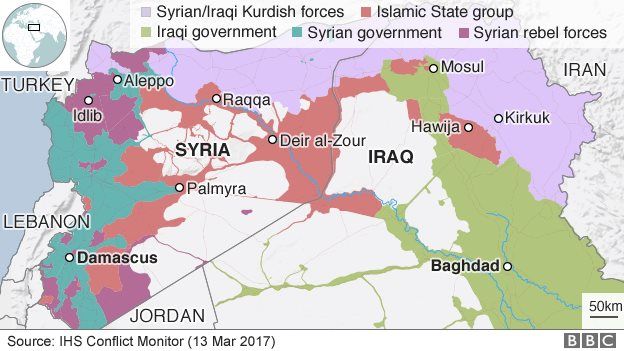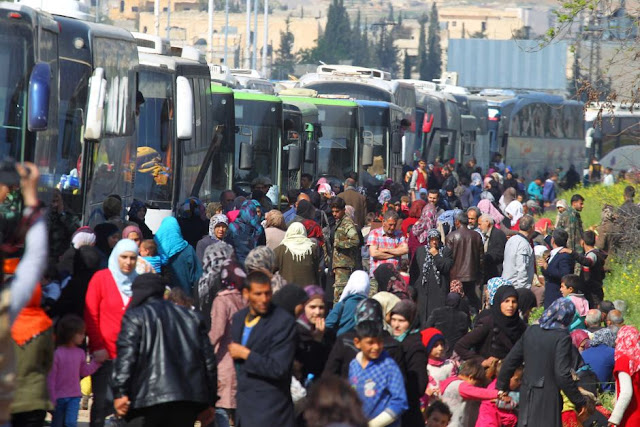According to people involved in the hostage deal, Qatar coughed up the money to release 9 members of the Gulf state’s royal family who were kidnapped in Iraq while on a falcon hunting trip.
 |
| One of the Qataris, Sheikh Nayef bin Eid Mohammed Al Thani, posted a series of photographs on the internet about a week before the kidnapping |
According to local sources, the breakdown of ransom is $120-$140 million to Tahrir al-Sham (former al-Nusra Front) and another $80 million Ahrar al-Sham (Free Men of the Levant) while funneling some $700 million to Tehran.
But how did Qatar strike the deal, and how did they manage to cover the huge amount of money transferring hands? - The Four Towns Deal.
The Four Towns Deal is an agreement reached between warring factions in Syria, and sponsored by - guess who - Qatar. The deal involved four towns in Syria described by UN as "catastrophic", with more than 64,000 civilians "trapped in a cycle of daily violence and deprivation".

Foah and Kefraya, most of whose residents are Shia Muslims, have been encircled by rebels and al-Qaeda-linked Sunni jihadists since March 2015.
Madaya and Zabadani, which are predominantly Sunni Muslims, have meanwhile been besieged since June 2015 by the Syrian army and fighters from Lebanon's Hezbollah.

Foah and Kefraya, most of whose residents are Shia Muslims, have been encircled by rebels and al-Qaeda-linked Sunni jihadists since March 2015.
Madaya and Zabadani, which are predominantly Sunni Muslims, have meanwhile been besieged since June 2015 by the Syrian army and fighters from Lebanon's Hezbollah.
In the "Four Towns Agreement", the warring parties have allowed the UN and Red Cross to deliver aid on a few occasions in the past two years and to evacuate limited numbers of sick and injured people. Aid convoys last reached the towns on 14 March. Several thousand civilians were also allowed to leave Foah and Kefraya in December as part of a deal that saw the evacuation of a besieged rebel enclave in eastern Aleppo. Madaya and Zabadani residents will be taken to rebel-held areas around the city of Idlib and the town of Jarablus.
Analysts theorized that Qatar has used the deal as a cover to fund jihadists. “If you want to know how Qatar funds jihadists, look no further than the hostage deal,” said a Syrian opposition figure who has worked with an al-Qaeda mediator on hostage swaps in Syria. “And this isn’t the first — it is one of a series since the beginning of the war.”
The deal highlighted why Qatar is frequently accused of funding jihadists in Syria, usually via hostage payments. But perhaps the upsetting fact is that Doha may have paid off Saudi Arabia's main regional rival, Iran, which they accuse of fueling conflicts in the Arab world. The hostage deal, masked by the Four Towns Agreement, is the trigger to this latest and most drastic diplomatic row in the gulf region.
Is there any proof to these outlandish theory? The timeline of events seem to fit. After 16 months in captivity, the Qatari hunting party walked free, returned by their captors to Iraq’s Interior Ministry in Baghdad. They were then delivered to the embassy of Qatar, which for days had stationed a plane at the airport in anticipation of their release. The evacuation of the four villages under the "Four Towns Agreement" happened about the same time.
Iraqi Shiite official said the release of the Qatari prisoners was linked to the safe evacuation of — and delivery of humanitarian aid to — residents of two Shiite villages in Idlib Province, Fouaa and Kfarya. As part of that agreement, residents of two predominantly Sunni villages, Madaya and Zabadani, that have been held by rebels but besieged by forces loyal to the Syrian government are to be bused to safety.
 |
| Civilians being evacuated as part of the Four Towns Deal |
The Qatar News Agency "hacking" incident and the showing of a video which appears to present Qatari Emir Sheikh Tamim bin Hamad al-Thani making inciting statements about Iran and Israel worsened the regional dispute and raised tensions to its highest levels, where it ended in the current situation.
source: FT. Al Bab
SEE ALSO
©2017 THOUGHTSKOTO
SEARCH JBSOLIS, TYPE KEYWORDS and TITLE OF ARTICLE at the box below





